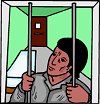- By Dan Veaner
- Around Town
 Print
Print  The Lansing Schools not only teaches children who live within the district, but is also responsible for teaching inmates at the county jail. "So why us? That's the question everybody asks," says the district's Director of Special Services and Grants Pam DiPaula. "Education law requires that the educational services in a jail, not prison, but a jail shall be provided by the school district in which the facility is located. That's where the jail is at the Public Safety building on Warren Road."
The Lansing Schools not only teaches children who live within the district, but is also responsible for teaching inmates at the county jail. "So why us? That's the question everybody asks," says the district's Director of Special Services and Grants Pam DiPaula. "Education law requires that the educational services in a jail, not prison, but a jail shall be provided by the school district in which the facility is located. That's where the jail is at the Public Safety building on Warren Road."DiPaula, whose main responsibility is managing special education in the district, administers the jail program. From the early 1970s to the early 2000s the program was run by BOCES. DiPaula says the BOCES program was a model program for State Incarcerated Youth programs in the early '90s. But with reduced staff and budget and additional requirements and restrictions, BOCES turned the responsibility over to the school district. The district, in turn, partners with Tompkins County Workforce New York with Lansing providing classes and Workforce New York providing career and life skills services. DiPaula says the program is very successful, with many participants finishing high school or earning their General Educational Development (GED) equivalency. A unique aspect of the Lansing program is that it provides a transition counselor, an employee of the Tompkins County Workforce who spends 50% of her time working with the jail program.
"So this is a unique service among New York county jails," DiPaula says. "We are one of the only programs that has a transition counselor who is both, what we call, 'inside and outside'. She does resumes, she fills out the Department of Labor application, skills and interests inventory, job placement, job research, and continuing education. We've had some inmates who have achieved a GED and then gone on to TC3. That's very exciting."
When students leave the program and are released from jail, the transition counselor continues to work with them, providing pre-employment counselling, interviewing, and resume building. The district keeps data on whether they got the job, and checks in 3 months, 6 months, and 9 months, and one year out to see if they are still working.
"Right now we have four innovative programs, DiPaula says. "We are starting to do some parenting programs and actually working with people who are incarcerated who have children. And parenting skills, but also creating things, making things, projects that they can share with their children. We're operating the Occupational Safety and Health Administration (OSHA) classes, and they are the preliminary classes people must take before they register with a union. And we have been able to offer those classes, both at the Community Justice Center and inside the facility, and what has happened is you have to take this course for 10 hours and then you get a certificate that you obtain this certification. And basically it takes care of all the pre-preparation training that you must do before you can even be an apprentice in the union. So we are bumping people ahead in the prospects of job development by providing them with these classes."
While the State pays for the jail program, and the County takes care of data reporting, the school district must administer it. DiPaula says it takes a half-day to a full day per week of her time, plus the district has to provide a full time teacher. The number of students varies from week to week, and sometimes from day to day as students join the program, or are released from jail. Aside from her time there are other costs to the district, because students older than 21 years old participate.
"Here's the good news and the bad news," DiPaula explains. "We have a really high GED passing rate. It's around 70% of the students. However, most of those students who are currently participating are over 21. So do the math around the reimbursement side of that is we are providing a teacher every day because we must, and most of the students at this point who are participating are over 21. There is a funding mechanism for reimbursement for the over 21's, but we haven't applied for that yet. We're not sure if we have enough stability to make that happen."
She says it is difficult recruiting a teacher for the program, because of difficult hours. "New York State Department dictates the classes must be at least three hours in length and instruct males separately from females," she notes. "Our facility very rarely has females, and we often hear females who have attended some level of college or higher education. So we don't have to do as many of these three hours for the males and three hours for the females as some other facilities do. Based on the schedule for the classroom at our facility, the best time for the teacher to go in and work with our students is 5pm-8pm, 6pm-9pm, that type of time so it is really hard to find a candidate who is interested in working the nights every night for such a small amount of time."
DiPaula takes pride in the quality and success of the program. "It is very novel," she says. "It is one of the things we are really proud of, we've had incredible participation, we have had a lot of people get certificates."
----
v3i13



